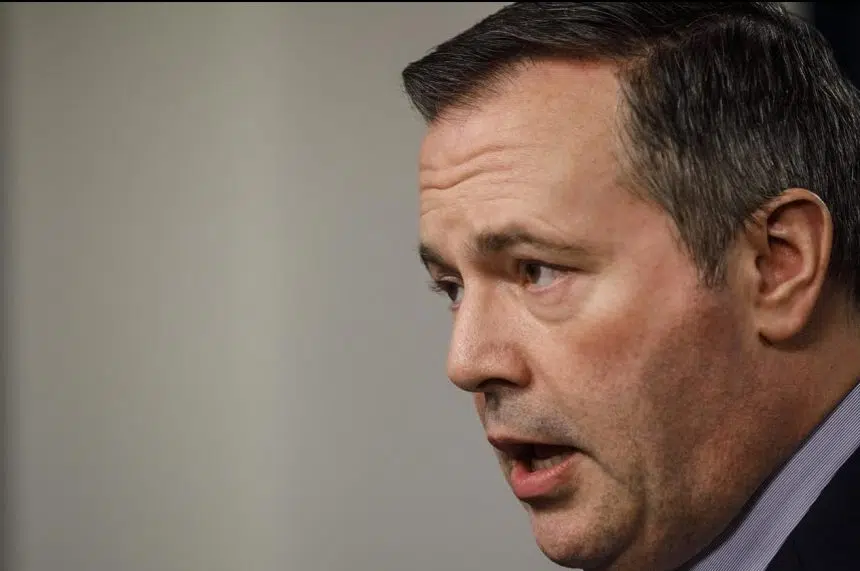EDMONTON – Premier Jason Kenney says forecast models for the COVID-19 crisis in Alberta predict anywhere from 400 to 6,600 deaths in the months to come.
Kenney, in a televised address Tuesday, said where the numbers go depends largely on the behaviour of Albertans.
“I want this to end as soon as you do,” said Kenney. “But we simply cannot risk letting the virus loose in Alberta.
“That would create a public health catastrophe, which would force an even more stringent lockdown in the future, leaving our economy even further battered.”
Alberta is under strict public health orders that clamp down on non-essential businesses and restrict public gatherings to no more than 15 people.
Kenney said those orders will be in place at least until the end of the month, with social distancing rules likely in place until the end of May.
He said the situation is fluid, and changes and decisions will be made depending on the rates of infections and fatalities.
The province is working with two models: A probable and elevated scenario.
Under the probable scenario, a peak number of infections is expected by mid-May, with as many as 800,000 infections by the end of summer and between 400 and 3,100 deaths.
Under the elevated scenario, infections would peak earlier, at the start of May, leading to as many as one million infections and between 500 and 6,600 deaths.
Alberta reported 25 new COVID-19 cases Tuesday, bringing the total to 1,373. There were two more deaths, bringing that number to 26.
Alberta, with a population of 4.4 million, has completed more than 67,000 tests, putting it among the global leaders in per-capita testing.
“We are confident that our health system will be able to cope, and that we have the supplies on hand to get the job done,” said Kenney.
Kenney said Alberta’s rate of hospitalizations is lower than in other large provinces, like British Columbia, Ontario and Quebec. But he noted those provinces also saw their first cases earlier.
Alberta reported its first case of the novel coronavirus March 5.
Kenney said the statistical “curve” of infections in the province resembles that in jurisdictions with success combating the virus, such as South Korea, compared with less successful countries, like the United States and Italy.
Once Alberta manages to contain the virus, Kenney said, the focus will shift to maintaining a clampdown while re-energizing an economy gutted by the pandemic and by an oil price war that has kicked the foundation out from under its bedrock industry.
The premier said a “relaunch strategy” will include mass testing, as many as 20,000 tests a day, to keep the virus in check. There will be more precise tracing to find out how those who test positive acquired the virus.
There will also be stronger and more rigorous screening and quarantining of international arrivals to Alberta.
Quarantine orders will be strictly enforced and people will be encouraged to use masks in crowded public spaces, like mass transit.
Kenney’s government has already put $12 billion into relief measures, either through direct aid or deferral of taxes and other fees, to assist Albertans and try to keep businesses that have closed their doors from closing them permanently.
He has said he is still looking for more federal aid to backstop liquidity for banks trying to help businesses stay afloat. He also wants money to keep the oil and gas industry going, particularly in the short-term by putting people to work reclaiming orphan wells.
Kenney said the economic outlook remains grim, with this year’s projected $7-billion budget deficit likely to balloon to almost $20 billion.
Earlier Tuesday, speaking online to a group of energy leaders, Kenney said: “I fully expect unemployment in Alberta to be at least 25 per cent – at least half a million unemployed Albertans – and it could be significantly higher than that.
“This will be the most challenging period in our economy in relative terms since the Great Depression. There is simply no doubt about it.”
Opposition NDP Leader Rachel Notley echoed Kenney’s plea for Albertans to keep physical distancing and practise the critical hygiene and hand-washing routines.
“Our ability to keep these numbers low is within our power and forms a shared responsibility for all Albertans,” said Notley. “We must follow the advice from public health officials.”
– With files from Bob Weber in Edmonton
Dean Bennett, The Canadian Press







